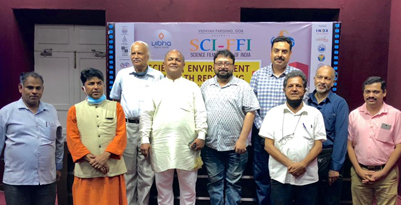All you want to know about the ‘Great Conjunction’ – TV Venkateswara
Once a lifetime opportunity: About 30 minutes after the local sunset, in the southwestern direction, low in the sky, two giant gas plants, Saturn and Jupiter will appear so close that we will not be able to distinguish them apart. The last time Jupiter and Saturn were this near was on July 16, 1623. The next time they will come again this close will take place only in 2080.
What is ‘great conjunction’? The inclination of the orbits of the planets around the Sun is more or less the same. Therefore, the five visible planets, Mercury, Venus, Mars, Jupiter, Saturn and the Moon, appear to follow the same path that the Sun takes in the sky. As athletes run along the track, one whose speed is higher catch up the slower one from behind. Likewise, as the speed at which one planet appears to move in the sky are not same, once in a while, the fast-moving one will catch up with the relatively slow-moving planet in the sky. Such events are called ‘conjunction’. When the jumbo planets, Jupiter and Saturn come close to each other, it is called as ‘Great Conjunction’.
How frequent? Jupiter and Saturn, which takes 11.86 years and 29.4 years, respectively to go around the Sun. Therefore, every 19.85 years they are aligned in a straight line with Earth, resulting in great conjunction. Likewise, other planets also produce periodic conjunction as they orbit Sun. For example, next year, on July 13, 2021, a conjunction of Venus and Mars will take place.
Why this year it is so special? The orbits of Saturn and Jupiter around the Sun are not on the same plane, hence, when they catch up with each other, the distance between them differ from one time to another. This time the separation between them will be just 0.1 degrees. In comparison, the angular distance between Arundhati (Alcor) and Vashista (Mizar) is 0.2 degrees! Hence only if you have exceptional eyesight, you will be able to distinguish them. Further, as Jupiter will be brighter than Saturn, they will shine like one single shining object in the sky.
Can’t I wait for the next one? A conjunction of Jupiter and Saturn occurs every 20 years. However, this time they will be exceptionally close. Last time when the great conjunction took place in 2000, the separation was 1.18 degree. When it again takes place in 2040 the separation will be 1.23 degree and in 2060, 1.15 degree. Which means the next two times, when the conjunction takes place, the planets will be eleven times farther apart than this year.
When to observe? Start today! The width of the tip of your little finger at arm’s length is about one degree. Since the beginning of the month, Jupiter has been edging closer to Saturn. The two planets are impressive sight easy to locate in the southwestern sky, after the sunset. On December 10, the angular distance between them was only 1.12 degrees. Using the little finger as a measuring instrument, you can note how they are getting closer with each passing day. Of course, the grand show is on the evening of December 21, 2020.
Where to look? Go to top of a tall building, or a place where you have an unobstructed view of the western horizon. As the twilight falls, Jupiter and Saturn will appear low in the sky. Look in the direction of the south-west. They will be so bright that it is hard to miss. The planets will set around 1930 IST, and hence the best time to watch is between the local sunset and 1900 hrs IST.
Is there any harm? The planets will not bump into each other at all! In fact, on December 21, 2020, though Jupiter and Saturn will appear close together, they will actually be about 600 million km apart! They are safe to watch with the naked eye. A binocular will be spectacular. Such events are periodic, and there is nothing to fear from them. No harm will befall either humans or the Earth.
Indian Astronomy: In ancient Indian astronomy the conjunction of planets is known by different names. The conjunction of a planet with Sun that is heliacal setting is called as astamaya; the conjunction of a planet with Moon is called samagama (union), and the conjunction of any two planets is called as yuddha (encounter). The conjunction of Sun and Moon is called as ‘grahan’.
Amazing facts: If you can time travel to AD 7541, you will witness two impressive celestial shows. On extraordinarily rare occasions, great conjunction is so close that Jupiter is right in front of the Saturn. When the Jupiter is right in the front of Saturn, either it partially eclipse (transit) or completely covers (occultation). February 16, 7541 there will be a transit and on June 17, 7541 there will be an eclipse of Saturn by Jupiter! In fact in the next 10,000 years only one more, on February 25, 8674 that a transit of Jupiter over Saturn will take place!
Next conjunctions: A conjunction between Venus and Mars will take place on July 13, 2021. In 2022, there will be a conjunction of Mars and Saturn on April 5, 2022, and Jupiter and Venus on April 30, 2022, and conjunction of Mars and Jupiter on May 29, 2020. There will be a solar eclipse on June 10, 2021, and December 4, 2021. Both of them will not be visible in India. Nonetheless the two lunar eclipses, in May and November 2021 will be visible from parts of India.
(India Science Wire)




